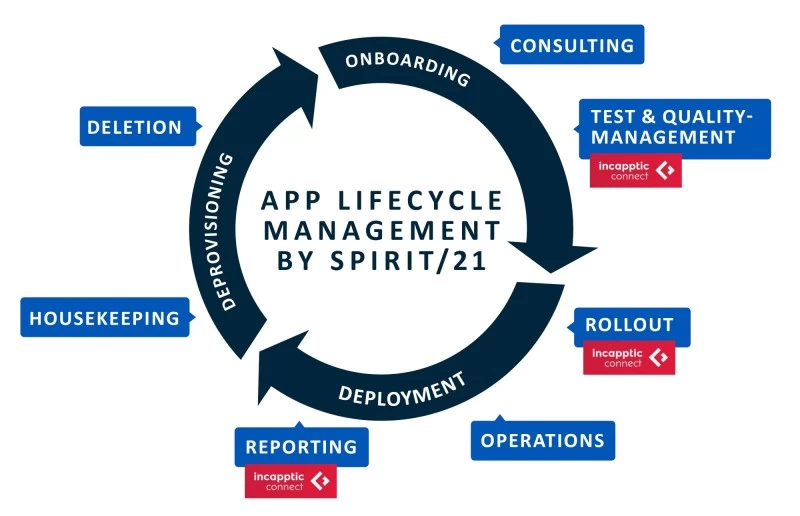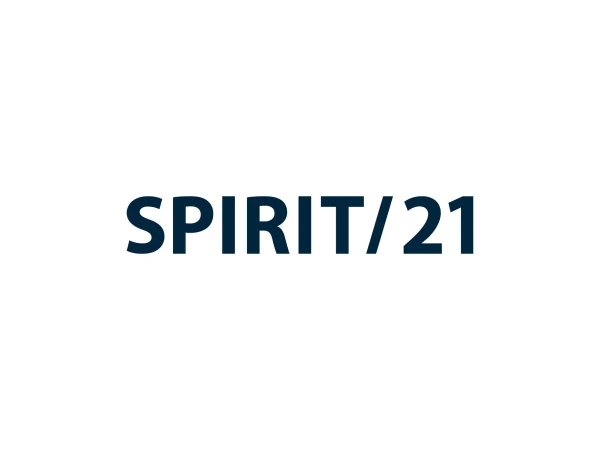From app release to app lifecycle management
In the previous articles in our series on this topic Application Lifecycle Management, we have described how apps are deployed efficiently, what hurdles can arise and how these can be overcome. However, if individual applications are to be managed over their entire lifecycle or even a complete application portfolio with a large number of end devices, other important components come into play.
“Application Lifecycle Management (ALM) describes the entire lifecycle of an application, from the initial idea to deletion. ” - SPIRIT/21
At SPIRIT/21, we divide holistic app lifecycle management into three interrelated phases: Onboarding, Deployment and Deprovisioning. The following section looks in more detail at the tasks that need to be completed in each phase and where standard software and individual solutions from SPIRIT/21 can contribute to success.

Onboarding: consulting and testing as core topics
The life cycle of an application starts in the onboarding phase, which begins long before the actual app development. The added value lies in advising the specialist departments as important stakeholders right from the start and presenting best practices. Questions about technical and organizational feasibility or the best possible integration into the company infrastructure can be clarified here before initial discussions are held with the development teams. As a basis for consulting, it is important to have a precise overview of the entire app portfolio. This is where integrated solutions from SPIRIT/21 bring valuable benefits: Multiple developments can be prevented, the profitability of apps can be increased and significant costs can be saved within the organization. Further synergies can be generated, for example, by setting up a code library for cross-app modules or with the help of a developer guide that provides information on agreed standards, guidelines and procedures centrally.
In addition to the technically specified process steps, the task descriptions of the stakeholders involved play a central role in test and quality management. If those involved are more closely involved in the processes and their responsibilities are expanded, experience has shown that this leads to higher motivation, greater satisfaction and therefore lower error rates. With this in mind, the approval workflow can be configured, for example, so that product managers or developer teams are authorized to independently feed applications into the process or distribute them to selected test/pilot groups. By testing apps in the productive system in advance, the quality of the distributed applications can be significantly increased. This is because errors that are difficult to detect in a dedicated test environment or on the developer’s test device can be avoided, e.g. incorrect app parameters, incorrect certificates or missing activations on other systems.
Deployment: Reduce risks during rollout - with solutions from SPIRIT/21
When rolling out apps, there is always a certain risk of jeopardizing the stability of running systems. This applies in particular to scenarios in which UEM systems are operated on-premises and a large number of end devices are managed. In this case, distribution can lead to routine tasks or core functions such as device registration and configuration assignments being delayed and, in the worst case, the system crashing. In addition, the bandwidth of the network should always be kept in mind. Due to the constantly increasing file size, the distribution of apps to several thousand end devices quickly results in significant amounts of data.
With this in mind, we have developed individual solutions for our rollout projects. They allow applications and configurations to be distributed in batches on a time-controlled basis. On the one hand, this allows the load to be shifted outside of regular office hours and, on the other, to be divided into system-compatible packages over a defined period of time. Another important aspect is the distribution of apps to specific target groups. Parameters that the UEM system itself does not provide can also be taken into account here. To do this, we access a wide range of backend systems via API and link organizational and technical data from the UEM systems in our solutions. This allows apps to be distributed dynamically to individually defined target groups. If the target groups change over time, these modifications are also mapped.
Operations: Monitoring and maintaining apps during operation
Monitoring provisioning profiles and push certificates are important tasks during operation. As soon as profiles and certificates have expired, applications can no longer be installed and notifications can no longer be sent within the app. To maintain these elementary functionalities, incapptic Connect monitors the expiry dates. System administrators and product managers are informed in good time and can initiate a corresponding renewal directly in the tool. There is another important aspect for operations in this context: “app configurations” need to be adapted more frequently over the course of their lifecycle. Experience has shown that new features are constantly being added after deployment. At the same time, interfaces such as the operating system, backend, manufacturer specifications or company guidelines change. Both have an impact on the functionality of the app.
Advanced reporting from SPIRIT/21: evaluation of various usage criteria
As soon as an app is distributed, experience shows that everyone wants to know how it is being used. In most cases, the UEM team reads the installation figures of the application(s) and regularly creates special reports for departments and product managers. The use of incapptic Connect offers a number of advantages for both sides: The fact that the installation figures for each app version are presented graphically means that those responsible can obtain a clear overview of the app’s distribution directly from the data in the UEM system. And the UEM team no longer has to create reports manually.
In large environments, however, evaluating installation figures alone is not enough. In order to optimize applications, the specialist departments ask more in-depth questions: Who is using the app? Does the app appeal to my target group? If so, on which device is the app being used? To answer these and similar questions, SPIRIT/21 offers a flexible solution with which targeted evaluations can be carried out on an app-specific basis. Specially configured dashboards provide additional information, such as device type, operating system version, management level or location, in addition to the installation figures. This makes extended reporting possible.
Deprovisioning: Automating housekeeping with SPIRIT/21
Operations, specialist departments and users view the application lifecycle from very different perspectives. In order to reconcile the requirements of the various stakeholders, SPIRIT/21 has developed an integrated solution: it helps operations to clean up unused applications, supports the specialist department in distributing updates promptly and provides users with the necessary information.
To do this, the solution continuously scans the app inventory on one or more UEM system(s) and checks which versions of an application are available and which are in use. For example, a configurable set of rules can be used to specify that productive apps may only be available in a maximum of three versions. Applications distributed for test purposes, on the other hand, could be limited to a maximum of one version.
Apps that have no installation numbers are automatically deleted. If there are multiple versions on the devices, users who are using an older version are informed of upcoming updates with regular email and push notifications. If the end device is a “supervised device”, the update is carried out directly. The iterations of this process are freely definable. In practice, it has been shown that a cycle of two to three runs is sufficient to distribute most of the latest version of an app. Once the process has been completed, the oldest version is deleted. If a user still has it installed, it disappears from the end device. If the user wants to use the app again, it must now be downloaded in the latest version from the company app store. All actions are logged within the SPIRIT/21 solution to make the process transparent, especially for business-critical applications and users.
Deletion: Delete unused applications regularly and correctly
Deploying apps faster, more securely and in the desired quality with the support of solutions such as incapptic Connect has many advantages. However, rapid deployment also leads to a growing number of new applications and shorter update intervals. In large UEM environments that are hosted in-house, this can quickly lead to problems with system memory if unused or outdated applications are not removed from the UEM system at a similar speed.
Removing an app may sound easy, but experience has shown that it is not quite that simple. This is because deleting the app by the administrator is usually just a marker for deletion. The actual removal from the database and therefore also from the system memory only takes place later at set intervals. In large environments, this interval is usually not nearly as short as it should be. This means that the applications to be deleted build up in the memory, affecting the size of the system backup, among other things. Accordingly, a high number of deployments can not only have a negative impact on the actual operation, but in the worst case can also unnecessarily prolong the recovery of the system. On the one hand, these difficulties can be overcome by harmonizing deployments and deletion intervals. On the other hand, regular deletions in defined maintenance windows help to free up storage space in the database.
This article rounds off our series of articles on the topic of app release management. Our aim was to give you an overview of the topic and an insight into the App Lifecycle Management by SPIRIT/21. We hope that we have succeeded in doing so. If we have not been able to answer all the questions relevant to you, please do not hesitate to contact us. Our UEM team will be happy to advise you and show you individual solutions on how to design the lifecycle of your entire app environment securely and efficiently.

Learn more

Application Lifecycle Management by SPIRIT/21 - Part 1: What processes are involved and which stakeholders are involved.

Application Lifecycle Management by SPIRIT/21 - Part 2: How processes can be designed efficiently and throughput times can be shortened.

App Lifecycle Management by SPIRIT/21 - Part 4: What is important for onboarding, deployment and deprovisioning.
Team SPIRIT/21
E-Mail: info@spirit21.com
The SPIRIT/21 team will be happy to advise you on all aspects of your IT tasks, from consulting and implementation to the operation of individual services and complete IT infrastructures. We deliver solutions that work. We look forward to hearing from you.

